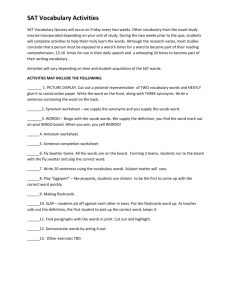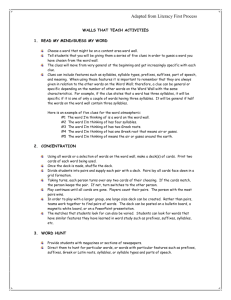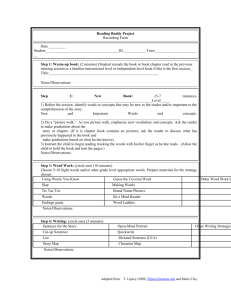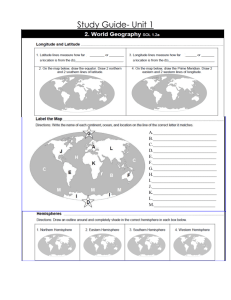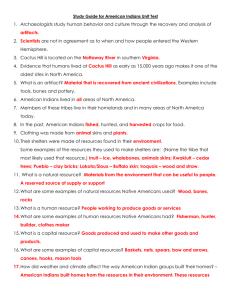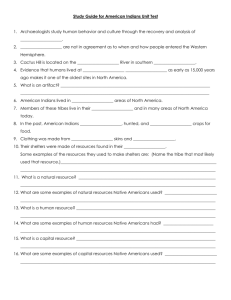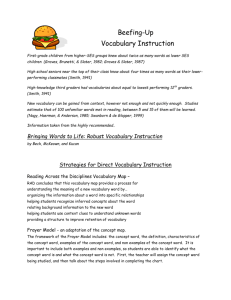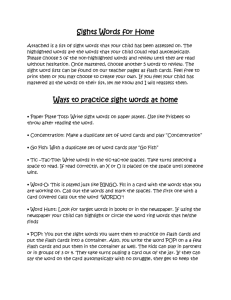American Indians SOL 3a-3c
advertisement
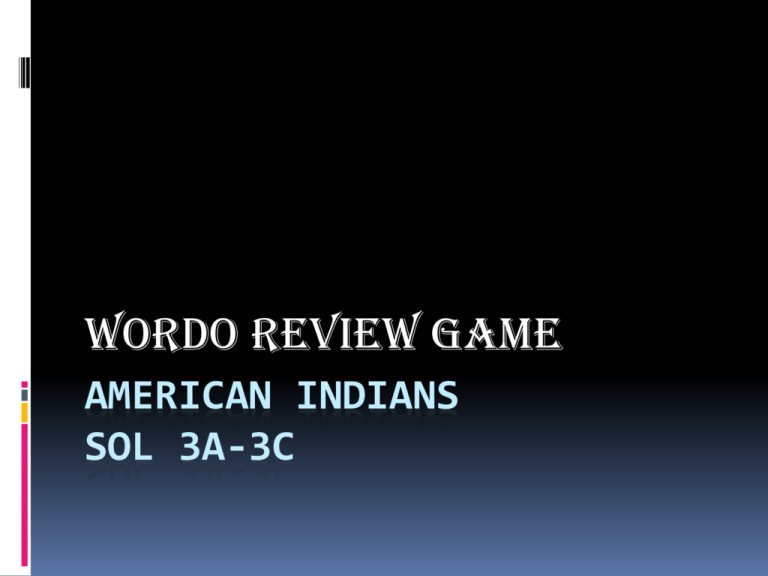
WORDO REVIEW GAME AMERICAN INDIANS SOL 3A-3C Inuit stationary Nottoway Lakota human artifacts natural Archaeology Capital Nomadic Cactus Hill Iroquois Pueblo archaeologist Kwakiutl Alaska & Northern Canada Eastern Woodlands Great Plains Southwest Bering Strait Pacific Northwest WORDO Objects that have been made, used, or changed by humans. Answer is… artifacts WORDO This American Indian group inhabited the PacificNorthwest coast. Clothing was made from the bark of cedar trees. Answer is… Kwakiutl WORDO This American Indian group inhabited the region that consists of dry grasslands with huge bison (buffalo) herds. Answer is… Lakota WORDO This American Indian group inhabited the heavily forested northeastern United States. Answer is… Iroquois WORDO This American Indian group inhabited in the Southwest which is modern-day Arizona and New Mexico. Answer is… Pueblo WORDO The scientific study of past cultures and the way people lived that is based on material evidence or things they left behind is known as __________. Answer is… archaeology WORDO Some scientists and archaeologists believe that humans may have lived in this location in southeastern Virginia as early as 15,000 years ago. One of the oldest archaeological sites in North America. Answer is… Cactus Hill WORDO An _____________ studies human behavior by taking clues left behind by the people of the past. Answer is… archaeologist WORDO ____________ resources come from nature. Answer is… Natural WORDO Name the American Indian group that inhabited this type of dwelling. Answer is… Iroquois WORDO Rivers, animals, cedar trees, and fish are examples of what type of resource? Answer is… natural WORDO Name the American Indian group that inhabited this type of dwelling. Answer is… Lakota WORDO Cactus Hill is located near the ______________ River. Answer is… Nottoway WORDO Name the American Indian group that inhabited this type of dwelling. Answer is… Inuit WORDO ___________ resources are the goods produced to make other goods and services. Answer is… Capital WORDO Name the American Indian group that inhabited this type of dwelling. Answer is… Pueblo WORDO Which region was characterized by dry grasslands where the Lakota hunted buffalo? Answer is… Great Plains WORDO American Indians fishing, hunting for animals, or making clothing is an example of what type of resource? Answer is… human WORDO Name the American Indian group that inhabited this type of dwelling. Answer is… Kwakiutl WORDO _____________ resources are people working to produce goods and services. Answer is… Human WORDO The Pueblo lived in this region which was a very hot, dry area that bordered cliffs and mountains. Answer is… Southwest WORDO It is believed that the humans entered North America from Asia by crossing the ___________ when ice covered its surface about 12,000 years ago. Answer is… Bering Strait WORDO The Kwakiutl, Pueblo, and sometimes the Iroquois were __________; they usually built their homes and stayed put. Answer is… stationary WORDO The Iroquois fished, hunted, and farmed the “three sisters”—corn , beans, and squash--in this heavily forested region. Answer is… Eastern Woodlands WORDO Canoes, bows, and spears are examples of what type of resources? Answer is… capital WORDO This group lived in present- day Alaska and northern Canada. Answer is… Inuit WORDO The Kwakiutl lived in this mild, rainy region. This region could get as much as 100 inches of rain a year. Answer is… Pacific Northwest WORDO The Inuit, Lakota, and sometimes the Iroquois were _________; they often moved to follow their food source. Answer is… nomadic WORDO The Inuit lived in this region where the temperature would sometimes get as low as 50 degrees below 0. Answer is… Northern Canada & Alaska
